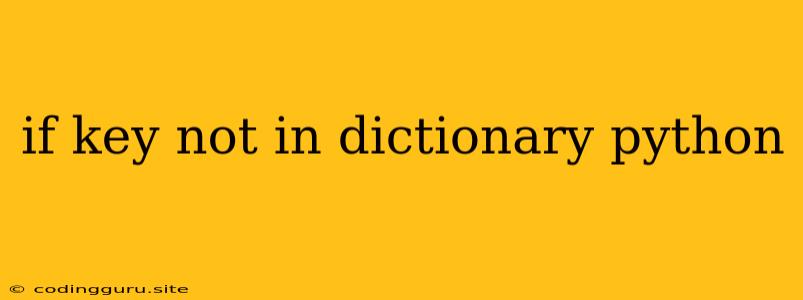Working with Dictionaries in Python: Handling Missing Keys Gracefully
Dictionaries are fundamental data structures in Python. They store data in key-value pairs, allowing you to access and modify information efficiently. However, a common challenge arises when you try to retrieve a value associated with a key that doesn't exist in the dictionary. This can lead to a KeyError, disrupting your program flow.
Let's explore the common ways to handle this scenario and ensure your code operates smoothly, even when encountering missing keys in your Python dictionaries.
The KeyError Problem: A Common Scenario
Imagine you're working with a dictionary representing a user's profile:
user_profile = {
"username": "john_doe",
"age": 30,
"city": "New York"
}
You want to access the user's favorite color, which isn't currently stored in the dictionary:
favorite_color = user_profile["favorite_color"]
This attempt will result in a KeyError, as the key favorite_color is not present. The Python interpreter will raise an exception, stopping your program's execution.
Strategies for Handling Missing Keys
Let's delve into the most practical solutions to avoid the KeyError and maintain your program's integrity:
1. The get() Method: A Safe and Flexible Approach
The get() method is a powerful tool for retrieving values from a dictionary without encountering KeyError exceptions. It allows you to specify a default value to return in case the key is missing:
favorite_color = user_profile.get("favorite_color", "Unknown")
In this example, if favorite_color is not found, the code assigns "Unknown" to the favorite_color variable. This method is a safe and elegant way to handle potential key absences.
2. The in Operator: Checking for Key Existence
Before attempting to access a value, you can use the in operator to check if a key exists within the dictionary. This prevents the KeyError by confirming the key's presence beforehand:
if "favorite_color" in user_profile:
favorite_color = user_profile["favorite_color"]
else:
favorite_color = "Unknown"
This approach ensures you access the value only if the key exists, eliminating the risk of the KeyError.
3. The try...except Block: Handling Errors Gracefully
The try...except block provides a robust mechanism for catching exceptions, including KeyError. This approach allows you to handle the error explicitly and continue program execution:
try:
favorite_color = user_profile["favorite_color"]
except KeyError:
favorite_color = "Unknown"
The code within the try block is executed. If a KeyError occurs, the code within the except block is executed, setting favorite_color to "Unknown".
Example: Integrating if key not in dictionary python Strategies
Let's create a simple Python script that showcases these strategies in action:
user_profile = {
"username": "john_doe",
"age": 30,
"city": "New York"
}
# Using the `get()` method
favorite_color_get = user_profile.get("favorite_color", "Unknown")
print(f"Favorite color (get): {favorite_color_get}")
# Using the `in` operator
if "favorite_color" in user_profile:
favorite_color_in = user_profile["favorite_color"]
print(f"Favorite color (in): {favorite_color_in}")
else:
favorite_color_in = "Unknown"
print(f"Favorite color (in): {favorite_color_in}")
# Using a `try...except` block
try:
favorite_color_try = user_profile["favorite_color"]
print(f"Favorite color (try): {favorite_color_try}")
except KeyError:
favorite_color_try = "Unknown"
print(f"Favorite color (try): {favorite_color_try}")
This script demonstrates how to handle missing keys using get(), in operator, and try...except blocks.
Conclusion
When dealing with dictionaries in Python, understanding how to handle missing keys is crucial. By employing the get() method, in operator, and try...except blocks, you can gracefully manage scenarios where keys are absent, preventing KeyError exceptions and ensuring your code executes smoothly. Choose the approach that best suits your specific needs and coding style to handle missing keys effectively in your Python dictionaries.
